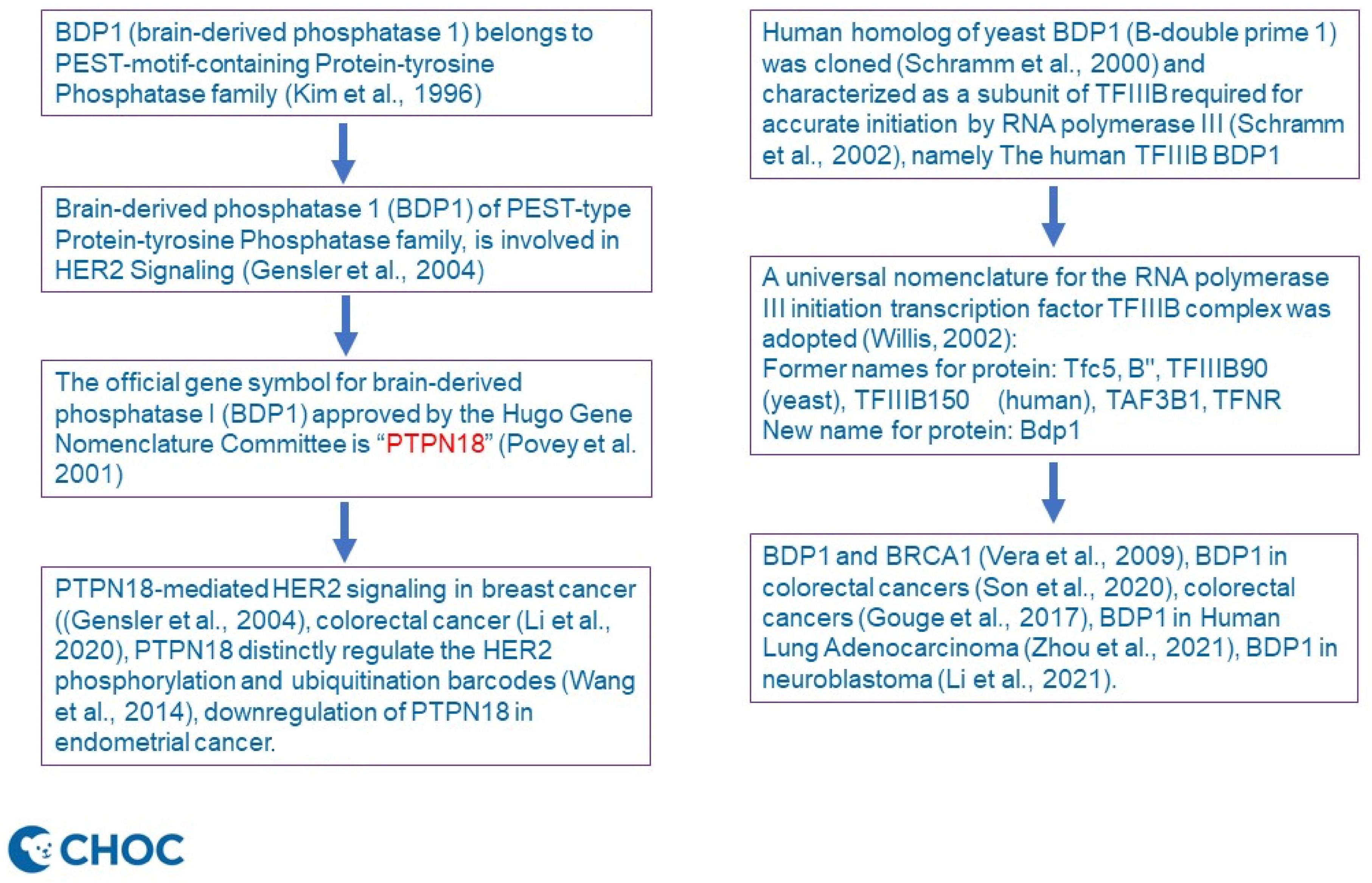Reply to Schramm, L. Comment on “Li et al. BDP1 Variants I1264M and V1347M Significantly Associated with Clinical Outcomes of Pediatric Neuroblastoma Patients Imply a New Prognostic Biomarker: A 121-Patient Cancer Genome Study. Diagnostics 2021, 11, 2364”
Funding
Conflicts of Interest
References
- Schramm, L.; Pendergrast, P.S.; Sun, Y.; Hernandez, N. Different human TFIIIB activities direct RNA polymerase III transcription from TATA-containing and TATA-less promoters. Genes Dev. 2000, 14, 2650–2663. [Google Scholar] [CrossRef] [PubMed] [Green Version]
- Schramm, L.; Hernandez, N. Recruitment of RNA polymerase III to its target promoters. Genes Dev. 2002, 16, 2593–2620. [Google Scholar] [CrossRef] [PubMed] [Green Version]
- Schramm, L. Comment on Li et al. BDP1 Variants I1264M and V1347M Significantly Associated with Clinical Outcomes of Pediatric Neuroblastoma Patients Imply a New Prognostic Biomarker: A 121-Patient Cancer Genome Study. Diagnostics 2021, 11, 2364. Diagnostics 2022, 12, 608. [Google Scholar] [CrossRef]
- Li, X.; Sun, L.; Stucky, A.; Tu, L.; Cai, J.; Chen, X.; Wu, Z.; Jiang, X.; Li, S.C. BDP1 Variants I1264M and V1347M Significantly Associated with Clinical Outcomes of Pediatric Neuroblastoma Patients Imply a New Prognostic Biomarker: A 121-Patient Cancer Genome Study. Diagnostics 2021, 11, 2364. [Google Scholar] [CrossRef] [PubMed]
- Schoenen, F.; Wirth, B. The zinc finger protein ZNF297B interacts with BDP1, a subunit of TFIIIB. Biol. Chem. 2006, 387, 277–284. [Google Scholar] [CrossRef] [PubMed]
- Veras, I.; Rosen, E.M.; Schramm, L. Inhibition of RNA polymerase III transcription by BRCA. J. Mol. Biol. 2009, 387, 523–531. [Google Scholar] [CrossRef] [PubMed]
- Kim, M.K.; Tranvo, A.; Hurlburt, A.M.; Verma, N.; Phan, P.; Luo, J.; Ranish, J.; Stumph, W.E. Assembly of SNAPc, Bdp1, and TBP on the U6 snRNA Gene Promoter in Drosophila melanogaster. Mol. Cell. Biol. 2020, 40, e00641-19. [Google Scholar] [CrossRef] [PubMed]
- Verma, N.; Hurlburt, A.M.; Wolfe, A.; Kim, M.K.; Kang, Y.S.; Kang, J.J.; Stumph, W.E. Bdp1 interacts with SNAPc bound to a U6, but not U1, snRNA gene promoter element to establish a stable protein-DNA complex. FEBS Lett. 2018, 592, 2489–2498. [Google Scholar] [CrossRef] [PubMed]
- Son, H.J.; Mo, H.Y.; Yoo, N.J.; Lee, S.H. Somatic mutations of cancer-related genes PELP1 and BDP1 in colorectal cancers. Pathol. Res. Pract. 2020, 216, 153107. [Google Scholar] [CrossRef] [PubMed]
- Gouge, J.; Guthertz, N.; Kramm, K.; Dergai, O.; Abascal-Palacios, G.; Satia, K.; Cousin, P.; Hernandez, N.; Grohmann, D.; Vannini, A. Molecular mechanisms of Bdp1 in TFIIIB assembly and RNA polymerase III transcription initiation. Nat. Commun. 2017, 8, 130. [Google Scholar] [CrossRef] [PubMed] [Green Version]
- Zhou, W.; Bai, C.; Long, C.; Hu, L.; Zheng, Y. Construction and Characterization of Long Non-Coding RNA-Associated Networks to Reveal Potential Prognostic Biomarkers in Human Lung Adenocarcinoma. Front. Oncol. 2021, 11, 720400. [Google Scholar] [CrossRef] [PubMed]
- Gensler, M.; Buschbeck, M.; Ullrich, A. Negative regulation of HER2 signaling by the PEST-type protein-tyrosine phosphatase BDP1. J. Biol. Chem. 2004, 279, 12110–12116. [Google Scholar] [CrossRef] [PubMed] [Green Version]
- Li, C.; Li, S.Z.; Huang, X.C.; Chen, J.; Liu, W.; Zhang, X.D.; Song, X.M.; Du, R.L. PTPN18 promotes colorectal cancer progression by regulating the c-MYC-CDK4 axis. Genes Dis. 2020, 8, 838–848. [Google Scholar] [CrossRef] [PubMed]
- Wang, H.M.; Xu, Y.F.; Ning, S.L.; Yang, D.X.; Li, Y.; Du, Y.J.; Yang, F.; Zhang, Y.; Liang, N.; Yao, W.; et al. The catalytic region and PEST domain of PTPN18 distinctly regulate the HER2 phosphorylation and ubiquitination barcodes. Cell Res. 2014, 24, 1067–1090. [Google Scholar] [CrossRef] [PubMed] [Green Version]
- Wang, H.; Peng, S.; Cai, J.; Bao, S. Silencing of PTPN18 Induced Ferroptosis in Endometrial Cancer Cells Through p-P38-Mediated GPX4/xCT Down-Regulation. Cancer Manag. Res. 2021, 13, 1757–1765. [Google Scholar] [CrossRef] [PubMed]
- Cai, J.; Huang, S.; Yi, Y.; Bao, S. Downregulation of PTPN18 can inhibit proliferation and metastasis and promote apoptosis of endometrial cancer. Clin. Exp. Pharmacol. Physiol. 2019, 46, 734–742. [Google Scholar] [CrossRef] [PubMed]
Publisher’s Note: MDPI stays neutral with regard to jurisdictional claims in published maps and institutional affiliations. |
© 2022 by the authors. Licensee MDPI, Basel, Switzerland. This article is an open access article distributed under the terms and conditions of the Creative Commons Attribution (CC BY) license (https://creativecommons.org/licenses/by/4.0/).
Share and Cite
Li, X.; Sun, L.; Stucky, A.; Tu, L.; Cai, J.; Chen, X.; Wu, Z.; Jiang, X.; Li, S.C. Reply to Schramm, L. Comment on “Li et al. BDP1 Variants I1264M and V1347M Significantly Associated with Clinical Outcomes of Pediatric Neuroblastoma Patients Imply a New Prognostic Biomarker: A 121-Patient Cancer Genome Study. Diagnostics 2021, 11, 2364”. Diagnostics 2022, 12, 617. https://doi.org/10.3390/diagnostics12030617
Li X, Sun L, Stucky A, Tu L, Cai J, Chen X, Wu Z, Jiang X, Li SC. Reply to Schramm, L. Comment on “Li et al. BDP1 Variants I1264M and V1347M Significantly Associated with Clinical Outcomes of Pediatric Neuroblastoma Patients Imply a New Prognostic Biomarker: A 121-Patient Cancer Genome Study. Diagnostics 2021, 11, 2364”. Diagnostics. 2022; 12(3):617. https://doi.org/10.3390/diagnostics12030617
Chicago/Turabian StyleLi, Xiaoqing, Lan Sun, Andres Stucky, Lingli Tu, Jin Cai, Xuelian Chen, Zhongjun Wu, Xuhong Jiang, and Shengwen Calvin Li. 2022. "Reply to Schramm, L. Comment on “Li et al. BDP1 Variants I1264M and V1347M Significantly Associated with Clinical Outcomes of Pediatric Neuroblastoma Patients Imply a New Prognostic Biomarker: A 121-Patient Cancer Genome Study. Diagnostics 2021, 11, 2364”" Diagnostics 12, no. 3: 617. https://doi.org/10.3390/diagnostics12030617
APA StyleLi, X., Sun, L., Stucky, A., Tu, L., Cai, J., Chen, X., Wu, Z., Jiang, X., & Li, S. C. (2022). Reply to Schramm, L. Comment on “Li et al. BDP1 Variants I1264M and V1347M Significantly Associated with Clinical Outcomes of Pediatric Neuroblastoma Patients Imply a New Prognostic Biomarker: A 121-Patient Cancer Genome Study. Diagnostics 2021, 11, 2364”. Diagnostics, 12(3), 617. https://doi.org/10.3390/diagnostics12030617







